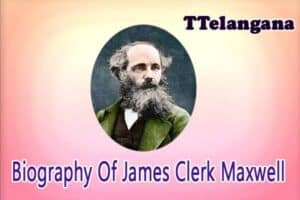Biography Of James Maxwell
James Maxwell was a prominent physicist. He was particularly notable for his contributions to understanding electromagnetism, and he created a single model of it. His research on kinetics, electricity, and quantum mechanics laid the foundations of modern Quantum mechanics.
“The world was forever changed by James Clerk Maxwell’s work.”
– Albert Einstein
Short Bio James Maxwell
James Clerk Maxwell (13 Jun 1831 – 5 Nov 1879).
James was born in Edinburgh in 1831. He was naturally curious from his earliest years, asking questions about how things work and why they move the way they do.
His mother died when he was eight years old and John, his father, took over responsibility for his education along with Jane, his sister-in-law. He attended the Edinburgh Academy in 1841. Although he was a good student, he took an interest in subjects that were not covered by the school curriculum, such as geometry, drawing, and maths. He wrote his first scientific paper, “Oval Curves”, at the age of 14.
He moved to Edinburgh in 1847 and studied logic, mathematics, and natural philosophy. He was, however, more interested in his research than the school curriculum. He studied the properties of polarized lights and prisms and also started his early research into electric and magnetic devices. He presented two more scientific papers at the age of 18; however, his tutor Kelland delivered them to the Royal Society instead.
He moved to Trinity College in Cambridge in 1850 and studied mathematics with William Hopkins, his great tutor. Maxwell received a high-ranking mathematics degree and was then able to pursue his research interests. This included studying the properties of color. In March 1855, he gave his first lecture to The Royal Society Of Edinburgh on his Experiments on Colour. He was also made a fellow in Trinity the following year. He applied for the Chair of Natural Philosophy at Marischal College in Aberdeen and was granted it. In 1857, he married Katherine Mary Dewar.
Biography Of James Clerk Maxwell

Aberdeen h spent part of his time marking exam papers and lecturing, but he also had the chance to explore other areas of research. His considerable talents were displayed by his theoretical explanation of Saturn’s Rings. It earned him PS130 as well as the Adams Prize from St John’s College in Cambridge.
He was struck with smallpox in 1860. However, he survived and moved to Kings College. He was able to meet Michael Faraday from the Royal Institute and made significant progress in his research in electromagnetism. He wrote one of his most significant works:
“This velocity is so close to that of light that it seems that we have strong reasons to conclude that light itself (including radiant warmth if applicable) is an electromagnetic disturbance in form of waves propagated through electromagnetic fields according to electromagnetic laws.” A Dynamical Theorie of the Electromagnetic Feld (1864), S20.
He returned to Glenair, Scotland in 1865 and wrote: “Theory of Heat” (1871).
He returned to Cambridge in 1871 and worked on the Cavendish laboratory’s development.
At 48 years old, he died from abdominal cancer.
James Maxwell was truly a polymath. He loved poetry and drawing, as well as his scientific discoveries. Although his eccentricity is apt, many of his contemporaries said that he was not graceful and confident in social situations. He was an evangelical Christian. He was also an evangelical Christian.
“I believe that scientists as well as men of other fields need to learn from Christ. I also think Christians who are interested in science should study it so that they may see the glory of God as far as their minds will allow. However, I believe that each man’s efforts to harmonize science and Christianity should not be considered as having any meaning except for him and his immediate family. (Draft of a response to an invitation to join Victoria Institute (1875), Ch. 12: Cambridge 1871 to 1879, p. 404)
James Maxwell Scientific Achievements
“Maxwell’s equations had a greater effect on human history than any ten Presidents.”
Carl Sagan
Maxwell’s greatest contribution to science was:
The speed at which electromagnetic fields are observed travels at the speed of light, demonstrating the link between light and electromagnetism.
Prediction of waves, oscillating magnetic and electric fields
For electromagnetism, writing equations. Later, known as Maxwell’s equations.
Albert Einstein later developed the concept of an electromagnetic field which led to his theory of special relativity.
His contributions to optics and color were the basis for practical color photography.
He also explained the phenomenon of color blindness
He created the Kinetic theory of gases, also known as Maxwell distribution.
Thermodynamics research
Control theory for steam engine centrifugal governors.
Many consider James Maxwell to be one of the three greatest scientists ever. It is comparable to Isaac Newton or Albert Einstein.
Maxwell’s work was once described by Einstein as “the:
“The most profound and fruitful physics experience since Newton,”
Einstein claimed that he had taken a photo of Maxwell, Michael Faraday, and Newton in his bedroom.
Tags:james clerk maxwell,james clerk maxwell (academic),maxwell,biography,james maxwell biography,james maxwell,biography of james maxwell,james clerk maxwell quotes,biography of james clerk mexwell in urdu hindi,james clerk maxwell photography,james maxwell biography for kids,james maxwell biography in english,james maxwell facts,james maxwell story,history of james maxwell,james clerk maxwell books,james clerk maxwell family,james clerk maxwell (author)
- Biography Of Joseph Lister
- Biography Of Gregor Mendel
- Biography Of Michael Faraday
- Biography Of Antoine Lavoisier
- Biography Of Antonie Philips van Leeuwenhoek
- Biography Of John Harrison
- Biography Of James Watt
- Biography Of Johannes Kepler
- Biography Of Galileo Galilei
- Biography Of Francis Bacon